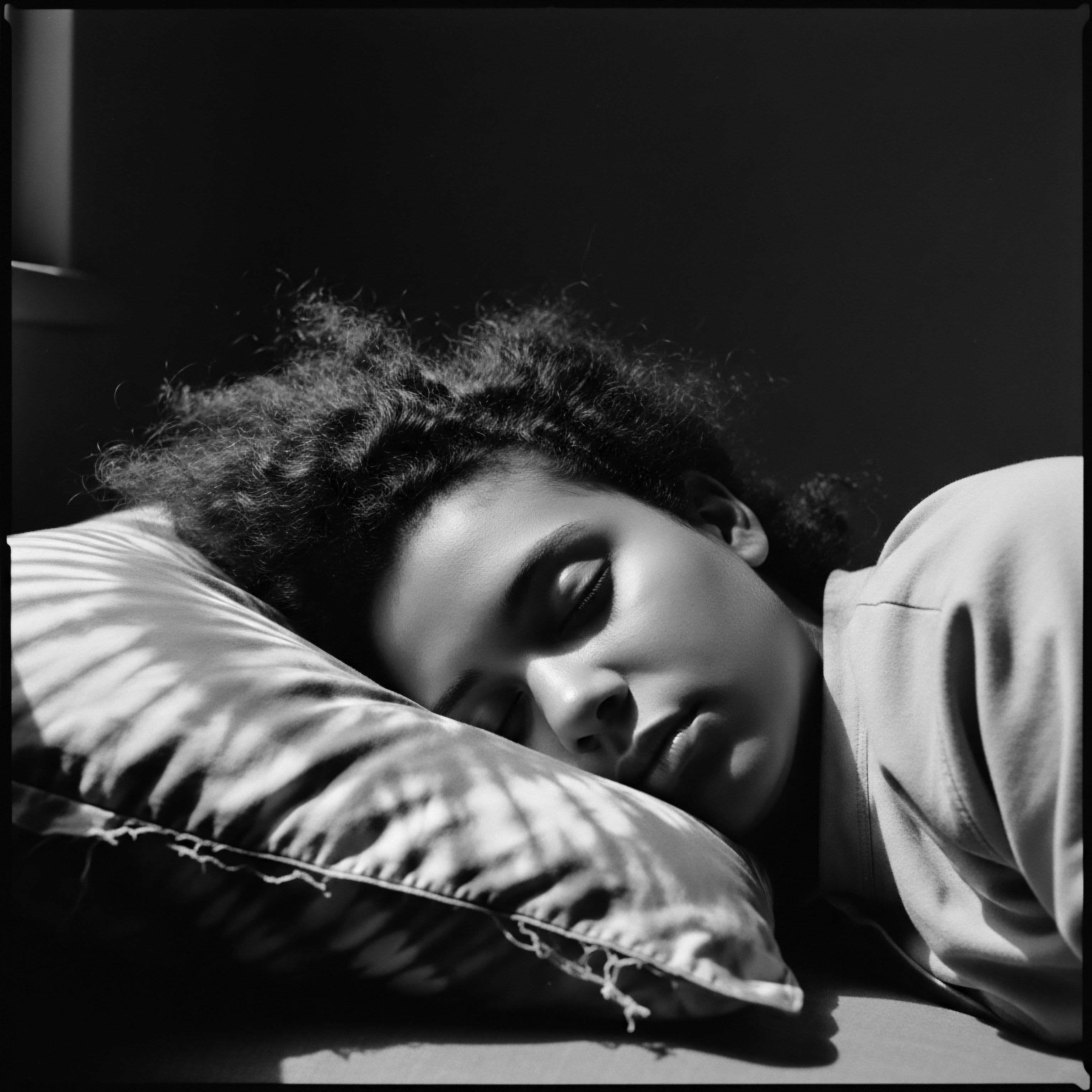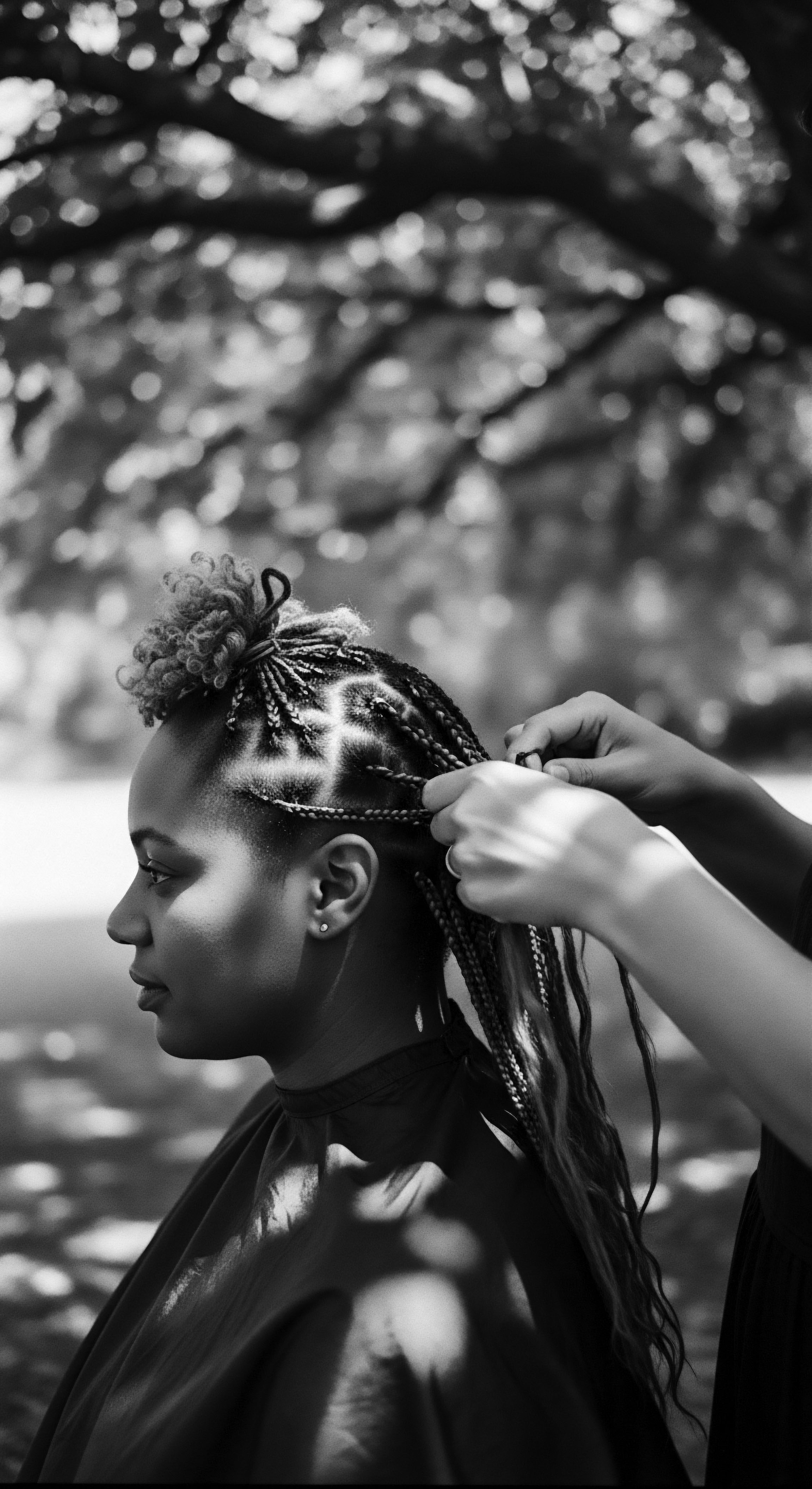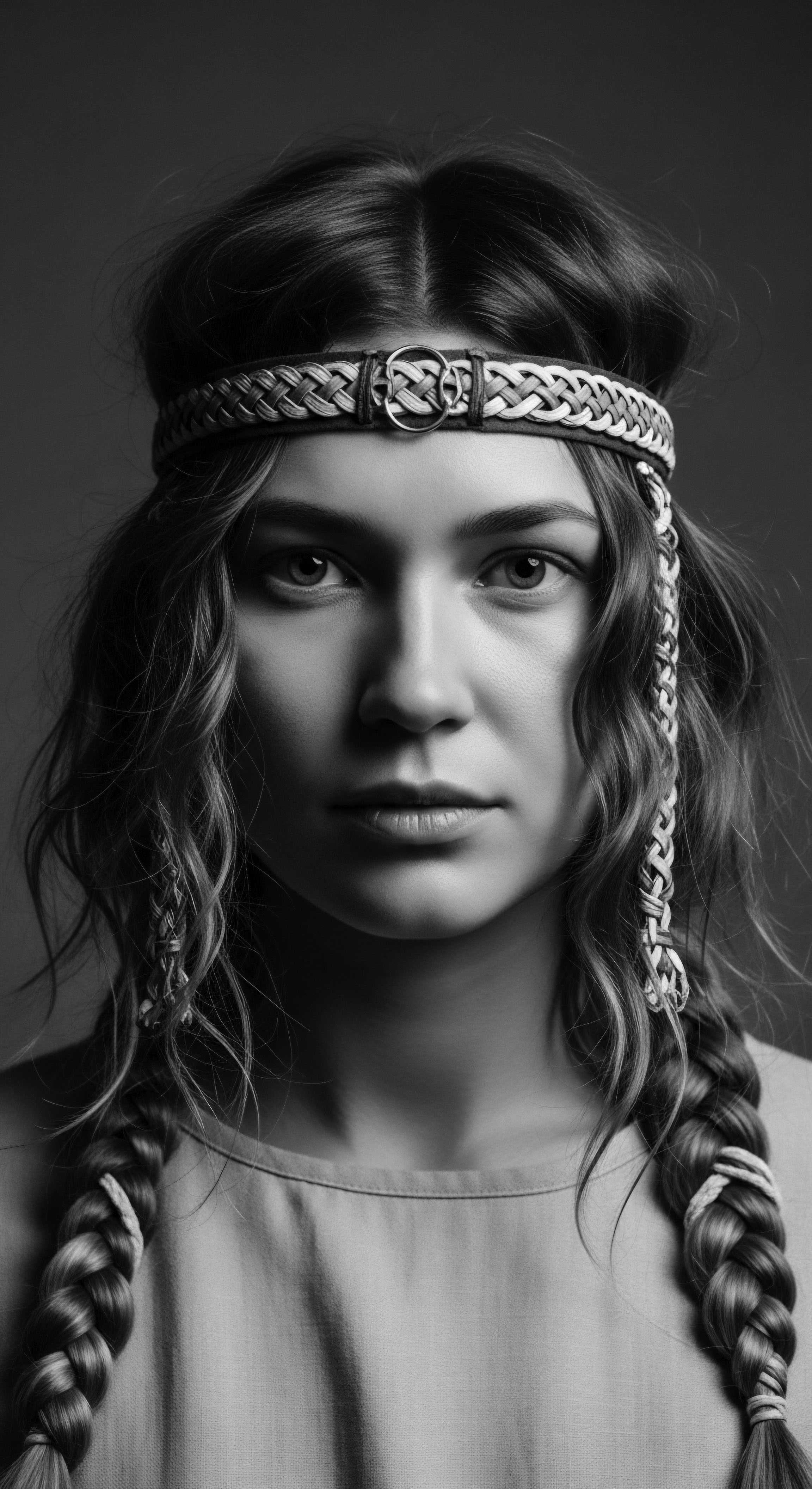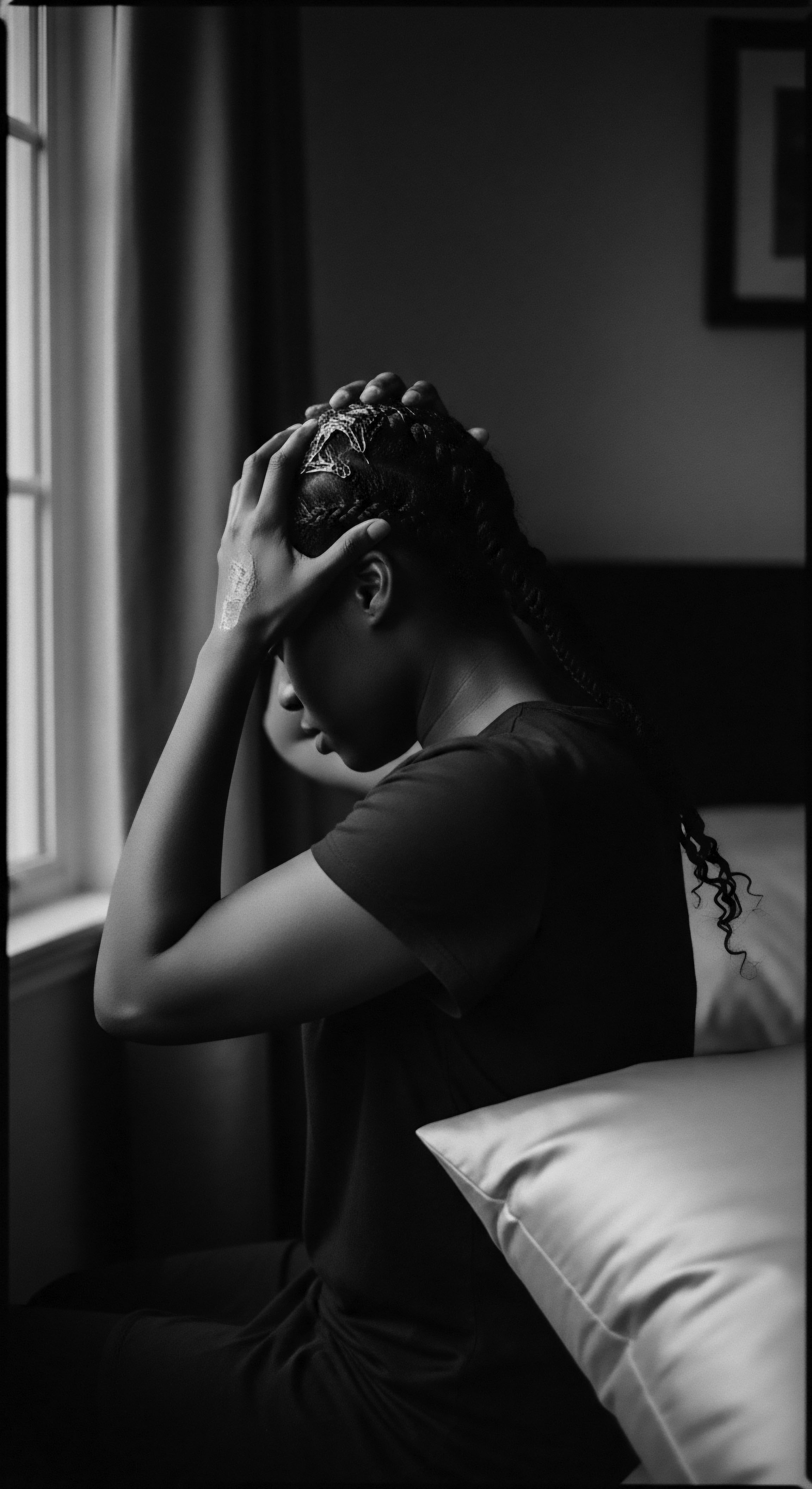
Roots
The very strands that crown our heads, particularly those with coils and textures that defy easy categorization, hold within their intricate geometry the echoes of ancient landscapes, enduring wisdom, and a profound connection to the earth itself. Consider, for a moment, the Himba women of Namibia, their hair painted with otjize , a paste of red ochre and butterfat. This practice, far from mere adornment, serves as both a cultural marker and a practical shield against the sun and insects.
The red earth clinging to their coils is a visible testament to their deep connection to the land and their ancestral past, a living history written in every carefully crafted twist. This enduring practice reveals a simple yet powerful truth ❉ care for textured hair has long been entwined with a respectful engagement with the environment, a reciprocity born of necessity and passed through generations.
Our journey into the historical link between braids and environmental protection for textured hair begins not in a sterile laboratory, but in the sun-drenched savannas and verdant forests where ancestral communities lived in close synchronicity with their natural surroundings. Here, understanding the very biology of textured hair—its unique helical shape, its varying porosities, its thirst for moisture—was not a matter of scientific study, but of intimate, generational observation. The earliest forms of hair care were, by their very nature, sustainable.
They relied upon what the earth generously offered ❉ plant-based oils, nourishing butters, mineral-rich clays, and natural fibers. These resources, harvested with discernment and used with intention, formed the foundational lexicon of textured hair well-being.
Ancestral hair practices, particularly braiding, inherently wove a reciprocal relationship with the natural world, reflecting a deep, sustainable engagement with the earth’s provisions.

Hair Anatomy and Ancient Understanding
The distinct structure of textured hair, characterized by its elliptical cross-section and numerous bends along the hair shaft, grants it a remarkable resilience, yet also presents particular needs. Unlike straight hair, which allows natural oils from the scalp to travel down the strand with ease, the curves and coils of textured hair impede this flow. This inherent characteristic means textured hair often requires external moisture to maintain its vitality and strength. Ancient communities, without the benefit of modern microscopy, understood this deeply through observation.
They recognized that hair, when left exposed to harsh environmental elements like intense sun, arid winds, or abrasive dust, could become dry and brittle. Their solutions were not fleeting fads, but robust systems of care that honored the hair’s inherent nature.
- Shea Butter ❉ Extracted from the nuts of the shea tree, a staple across West Africa, this rich butter provided powerful moisture and a protective barrier against environmental stressors, used for millennia for hair and skin.
- Marula Oil ❉ Sourced from Southern Africa, marula oil was valued for its light weight and rapid absorption, offering nourishment without heavy residue, guarding against harsh weather conditions.
- Rhassoul Clay ❉ From Morocco, this mineral-rich clay cleansed the hair and scalp without stripping its natural oils, allowing for effective yet gentle purification when water was a precious resource.
These plant-based remedies were not merely cosmetic applications; they were expressions of Traditional Ecological Knowledge (TEK), a cumulative body of wisdom acquired by indigenous peoples over centuries through direct contact with their environment. This knowledge recognized the interconnectedness of all living things, emphasizing balance in nature. The care for textured hair was thus an extension of a broader, respectful worldview that understood human well-being as inseparable from the well-being of the land.

Early Classification and Cultural Origins
Before the imposition of external classification systems, the nuanced textures and forms of textured hair were understood through a lens of cultural significance and societal roles. Hair was a language, its style a visual identifier of tribal affiliation, age, marital status, social rank, or even spiritual beliefs. The distinctions made were not about type numbers, but about the specific expressions of communal identity and personal journey.
For example, Himba young women wore two braids, known as ozondato , symbolizing youth and innocence, shifting to a face-covering braid upon readiness for marriage. This system, rooted in observation and cultural meaning, had no need for arbitrary scales; it instead reflected the rich diversity of human experience and connection.
| Traditional Element Plant-Based Oils (e.g. Shea, Marula) |
| Environmental Linkage Sustainably harvested, biodegradable, provide natural UV and moisture protection, reduce reliance on synthetic chemicals. |
| Traditional Element Clay (e.g. Rhassoul, Red Ochre) |
| Environmental Linkage Mineral-rich, non-toxic cleansers, protect from sun and insects, derived directly from the earth. |
| Traditional Element Protective Braiding Styles |
| Environmental Linkage Reduce manipulation, minimize product consumption, guard hair from elemental damage, extend wash cycles, conserve water. |
| Traditional Element The legacy of these ancestral practices highlights a profound ecological awareness in textured hair care. |
The cyclical nature of hair growth, its renewal and shedding, mirrored the natural rhythms of the seasons and agricultural cycles. Ancient practices often incorporated rituals that acknowledged this organic process, linking hair’s vitality to the fertility of the land. Sylvia Ardyn Boone (1986) noted that in many West African societies, the health and abundance of a woman’s hair were directly symbolic of her connection to the earth’s fertility and her ability to bring forth life and prosperity, a deep conceptual link between personal well-being and ecological flourishing. This deep spiritual and cultural connection ensured that hair was treated with reverence, not as a commodity to be exploited, but as a living extension of self and nature.

Ritual
The act of styling textured hair, particularly through the creation of braids, has always been more than a simple aesthetic pursuit; it is a ritual. These rituals are deeply interwoven with cultural meaning, social bonding, and a quiet, inherent environmental consciousness. From the communal braiding sessions that became spaces for intergenerational knowledge transfer to the selection of tools and materials, each step held a deeper significance. The choice of natural resources, the longevity of styles, and the minimal intervention approach all speak to a past where environmental protection was not a separate movement, but an organic component of daily life and beauty practice.

Protective Styles and Environmental Resilience
Braiding, in its myriad forms, has long stood as a cornerstone of textured hair care. Cornrows, twists, and various plaited styles served a dual purpose ❉ they adorned the wearer with beauty and cultural identity, while also safeguarding the hair from environmental rigors. These styles reduce daily manipulation, minimizing breakage and tangling, which in turn reduces the need for frequent washing and the subsequent use of water and cleansing agents.
In environments where water access was a challenge, or where harsh climatic conditions prevailed, protective styles were a wise and sustainable choice. They extended the life of a style, allowing individuals to navigate their days without constant re-styling or exposure to damaging elements.
Consider the ingenuity in prolonging a style. By securing the hair in braids, exposure to dust, strong winds, and intense sunlight diminished. This protective shield meant less cleansing, fewer products, and less wear and tear on the hair fibers themselves.
The lifespan of a braided style could range from weeks to months, a testament to efficiency and resourcefulness. This practice speaks to a fundamental understanding of longevity, where hair, like other resources, was conserved and treated with deliberate care to ensure its endurance.
Braids, as protective styling, embodied ancient ecological wisdom by extending hair’s longevity and minimizing resource consumption in daily care.

How do Traditional Braiding Techniques Minimize Environmental Impact?
Traditional braiding techniques, often taught and perfected within communal settings, inherently promoted environmental responsibility through several means. Firstly, they favored natural hair, minimizing or eliminating the need for chemical treatments that could pollute water sources and harm the hair itself. Secondly, the styles themselves were designed for durability, meaning less frequent washing and re-styling. This reduced water usage, a critical consideration in many arid or semi-arid regions of Africa.
Thirdly, the emphasis was on working with the hair’s natural texture rather than trying to force it into unnatural forms, which reduced breakage and product dependency. Finally, the tools used were typically crafted from natural, locally available materials, often biodegradable, ensuring minimal waste.

Tools and Transformations Grounded in Earth
The tools of ancestral hair styling were extensions of the natural world. Carved from wood, bone, or horn, these combs, picks, and styling instruments were durable, reusable, and eventually returned to the earth. Contrast this with the plastic combs and brushes that saturate modern markets, products that contribute to waste streams and microplastic pollution. The traditional approach fostered a circular economy of beauty, where materials were sourced sustainably and utilized mindfully.
The transformative power of braiding was not just about appearance; it was about preparing hair for its journey through various life stages and environmental shifts. During rites of passage, before long journeys, or in anticipation of certain seasons, hair might be braided in specific ways that offered both spiritual protection and physical resilience against the elements. For example, during colonialism, certain African hairstyles were forbidden by European colonizers, precisely because they were seen as symbols of resistance and African pride, highlighting the deep cultural significance beyond mere appearance. The hairstyles themselves became a quiet act of environmental protection, insulating the scalp and hair, much like a natural canopy.
| Traditional Tool/Method Wooden Combs/Picks |
| Environmental Impact Biodegradable, renewable resource, low energy production. |
| Modern Counterpart Plastic Combs/Brushes |
| Environmental Impact Petroleum-based, non-biodegradable, contribute to landfill waste and microplastics. |
| Traditional Tool/Method Natural Plant-Based Cleansers |
| Environmental Impact Biodegradable, gentle on waterways, often locally sourced. |
| Modern Counterpart Synthetic Shampoos (with sulfates) |
| Environmental Impact Chemical pollutants, can be toxic to aquatic life, require energy-intensive manufacturing. |
| Traditional Tool/Method Communal Braiding Sessions |
| Environmental Impact Reduces individual resource consumption, promotes knowledge transfer, minimizes reliance on commercial products. |
| Modern Counterpart Individual Salon Visits/DIY Styling |
| Environmental Impact Higher resource consumption (electricity, water, product packaging), reliance on manufactured goods. |
| Traditional Tool/Method The legacy of traditional tools and practices illustrates a conscious alignment with ecological preservation. |
The emphasis on natural oils and butters for maintenance, rather than heavy styling products, further reduced environmental strain. These applications sealed moisture into the braids, keeping the hair supple and preventing dryness, thus extending the time between washes and reducing overall product consumption. This holistic approach respected the hair’s natural inclination while working with the resources the earth offered, fostering a sustainable loop of care and renewal.

Relay
The historical link between braids and environmental protection for textured hair finds its most compelling expression in the continuous relay of ancestral wisdom, carried forward from generation to generation. This relay is not merely anecdotal; it is substantiated by a body of Traditional Ecological Knowledge that speaks to a sophisticated understanding of botanical resources and sustainable practices. The integration of scientific insights with this inherited wisdom allows us to fully appreciate the profound ecological literacy embedded within textured hair heritage.

Traditional Ecological Knowledge and Hair Biogeography
Traditional Ecological Knowledge (TEK), often transmitted orally through practices like communal braiding sessions, holds invaluable insights into sustainable resource management and environmental adaptation. For textured hair, this knowledge manifested in the judicious selection and application of plants and natural compounds. For instance, the systematic review by Nyamu et al. (2024) identified 68 plant species used in African hair treatment and care, with Lamiaceae, Fabaceae, and Asteraceae being the most represented families.
These plants were employed for conditions ranging from hair loss to scalp infections, demonstrating an empirical understanding of their properties over centuries. Many of these species, like Citrullus lanatus (Kalahari Desert Melon) in South Africa, are now being recognized for their potential in modern hair care products, economically empowering local communities. This systematic botanical knowledge directly informed practices that were inherently low-impact and regenerative, protecting both hair and habitat.
Consider the ecological footprint of these traditional remedies. Unlike the energy-intensive manufacturing processes of synthetic hair products, which contribute to carbon emissions and landfill waste through plastic fibers like polyvinyl chloride (PVC) and acrylic, ancestral practices relied on direct plant extracts and minimally processed raw materials. The cultivation and harvesting of plants for hair care, when practiced sustainably, fostered biodiversity and maintained ecological balance. This stood in stark contrast to the extractive and polluting models that would later become dominant.
The enduring wisdom of ancestral hair care, transmitted through generations, offers a profound framework for modern environmental responsibility.

What Ancestral Practices for Textured Hair Highlight Environmental Reciprocity?
Ancestral practices for textured hair often highlighted environmental reciprocity through their reliance on local flora and fauna. The Himba people’s use of otjize , composed of red ochre and butterfat, serves as a powerful example of direct environmental engagement. This paste not only protects their hair and skin from the harsh desert sun and insects but also symbolically links them to the reddish earth of their ancestral lands.
The butterfat component, likely derived from livestock, represents a careful stewardship of animals, while the ochre is a direct gift from the earth. This practice is a micro-economy of natural resources, where the environment provides, and the community, through its hair care, expresses its reverence and connection to that environment.
Another compelling example arises from the Basara Tribe of Chad , whose practice of applying an herb-infused oil and animal fat mixture, often referred to as Chebe , showcases a profound understanding of hair health and longevity. This mixture is applied to hair and then braided, a method that demonstrably aids in extreme length retention. This approach minimizes manipulation and thus reduces breakage and shedding, inherently lessening biological waste.
The ingredients are natural, biodegradable, and locally sourced, contrasting sharply with the synthetic hair extensions that contribute to significant plastic waste in landfills, often taking hundreds of years to degrade. The very act of caring for hair in this manner becomes a form of environmental stewardship, promoting longevity and minimizing ecological burden.
- Chebe Powder (Chad) ❉ An herb-infused mixture applied with animal fat, then braided, renowned for length retention, reducing need for frequent manipulation or disposal.
- Yucca Root (Native American Traditions) ❉ Used to create a natural shampoo, it produces a soapy lather that cleanses without harsh chemicals, showcasing a biodegradable cleansing solution.
- African Black Soap (West Africa) ❉ Made from dried plantain peels, cocoa pods, and shea tree bark, this soap provides natural cleansing and nourishment, returning organic materials to the earth after use.
The intersection of hair care and environmental justice is another dimension where the historical relay of knowledge becomes critical. The displacement of people of African descent from their traditional environments, coupled with the systemic pressure to conform to Eurocentric beauty standards—often involving toxic chemical relaxers—resulted in both personal and environmental degradation. These chemicals pollute waterways and harm the hair’s natural composition. The contemporary natural hair movement, therefore, is not simply a style choice; it is a profound act of resistance and a reaffirmation of ancestral connections to natural hair and, by extension, to environmental well-being.

The Science of Sustainable Strands
Modern scientific understanding validates many principles inherent in traditional hair care. The concept of “protective styling,” for instance, is now understood through the lens of reducing mechanical stress on the hair shaft, preventing cuticle damage, and maintaining the hair’s natural moisture balance. Textured hair, with its unique structural properties, is particularly prone to dryness and breakage if not adequately cared for. Braids minimize external friction and exposure, creating a micro-environment that preserves hair health and longevity.
Moreover, the natural oils and butters employed ancestrally possess properties that modern science recognizes as beneficial. Shea butter, for example, contains fatty acids that mimic the natural lipids of the skin and hair, offering emollient and anti-inflammatory effects. Marula oil is rich in antioxidants, protecting hair from environmental damage caused by free radicals. These compounds provide genuine protective and nourishing qualities that reduce the need for synthetic alternatives, often laden with ingredients that are either non-biodegradable or derived from non-renewable resources.
| Product Category Natural Butters & Oils |
| Traditional/Cultural Connection Ancestral remedies, often part of communal rituals, represent connection to land and heritage. |
| Environmental Impact Renewable, biodegradable, often locally sourced, minimal processing, low waste. |
| Product Category Synthetic Hair Extensions |
| Traditional/Cultural Connection Modern adaptation for protective styles, but largely disconnected from heritage materials. |
| Environmental Impact Plastic-based, non-biodegradable, high energy production, contribute to microplastic pollution and landfills. |
| Product Category Chemical Relaxers/Dyes |
| Traditional/Cultural Connection A historical consequence of Eurocentric beauty pressures, often linked to historical trauma. |
| Environmental Impact Toxic chemicals, pollute water sources, can harm hair and scalp, contribute to unsustainable production. |
| Product Category Choices in hair products carry a legacy, either honoring ancestral ecological wisdom or contributing to environmental strain. |
The transmission of knowledge regarding these ingredients and techniques, often through oral braiding sessions, is a form of cultural conservation that directly contributes to environmental protection. It bypasses formal education systems, relying on direct human connection and lived experience. It is estimated that over 80% of rural African women learn their cultural heritage and values through these braiding sessions, linking the creation of hairstyles to storytelling and the transmission of values.
This oral lineage preserves not only styling methods but also the deep ecological understandings associated with the resources required. This collective wisdom, when valued and applied today, offers a pathway toward more sustainable beauty practices that honor both heritage and planet.

Reflection
As the sun dips below the horizon, casting long shadows across time, we are invited to consider the enduring legacy of textured hair and its indelible connection to environmental protection. The story of braids, far from a mere aesthetic trend, is a profound testament to ancestral ingenuity, resilience, and a deep reverence for the natural world. Each strand, each meticulously crafted braid, carries the whispers of generations who understood that care for self could not be separated from care for the earth. The ‘Soul of a Strand’ ethos reminds us that our hair is a living archive, a repository of heritage that continues to speak volumes about our place in the world.
From the ancient, earthy embrace of otjize on Himba coils to the resourceful application of Chebe by the Basara people, we see a consistent thread of sustainability woven through the very fabric of textured hair practices. These were not merely acts of styling; they were acts of stewardship, where natural materials were cherished, water was conserved, and the longevity of a style was prioritized. The collective memory of these practices, passed down through the intimate, communal rituals of braiding, serves as a powerful antidote to the disposable culture that often defines modern beauty.
In the contemporary landscape, where concerns about ecological balance grow louder, the wisdom of our ancestors offers a luminous path forward. Reclaiming traditional hair care practices, choosing natural ingredients, and embracing protective styles allows us to reconnect with a heritage that intrinsically understood environmental reciprocity. Our hair, in its glorious texture and form, stands as a symbol of resilience, a living link to those who walked before us, reminding us that true beauty blossoms when we honor both our heritage and the planet that sustains us. This ongoing conversation, this living library of hair traditions, continues to shape our present and inspire a more harmonious future.

References
- Bebrų Kosmetika. (2024, August 23). The Power of Hair in African Folklore ❉ Rituals and Traditions.
- Sellox Blog. (2021, June 4). Ancient African Hair Growth Secrets For Healthy Hair.
- 22 Ayur. The Ancient Natural Ways of Hair Care Across Continents.
- Afriklens. (2024, November 1). African Hairstyles ❉ Cultural Significance and Legacy.
- Claremont Colleges. (2023, April 17). The Intersection Between Black Hair and the Environment ❉ Hair as a Site for Environmental Justice and Sustainability.
- Nyamu, D. P. Aloo, S. & Kinyua, A. (2024, February 1). Cosmetopoeia of African Plants in Hair Treatment and Care ❉ Topical Nutrition and the Antidiabetic Connection? MDPI.
- Yaye. (2025, March 8). Shampoo & Conditioner with a Purpose – Indigenous Haircare for Healthy.
- Tampere Universities. (2021, November 1). Black Hair Care and the Environment | From the Perspecitve of Environmental Engineering Students.
- ACS ES&T Water. (2025, January 10). Environmental Consequences of Synthetic Hair Use from a Black British Perspective (and some eco-friendly alternatives).
- UNESCO. (2024, February 25). UNESCO moves to preserve African braiding culture, trains young ladies on hairmaking.
- Hair is More Than Just Hair. (2025, January 23). Hair Care Practices from the Diaspora ❉ A Look at Africa, America, and Europe.
- Kula Foods. (2023, August 8). A brief explanation of African plant-based and its roots in African heritage.
- DigitalCommons@USU. (2024, February 22). Braiding Indigenous and Western Knowledge through Traditional Cultural Camps ❉ Decolonial Learning Conversation between Indigenou.
- ResearchGate. (2024, February 1). Cosmetopoeia of African Plants in Hair Treatment and Care ❉ Topical Nutrition and the Antidiabetic Connection?
- Quora. (2017, June 22). How did black people do their hair in Africa before slavery began?
- U.S. National Park Service. (2024, June 26). Overview – Indigenous Knowledge and Traditional Ecological Knowledge.
- Indigenous Climate Action. (2024, April 15). Traditional Ecological Knowledge ❉ The Cornerstone of Indigenous Climate Adaptation in Canada.
- Haku Holistics. (2023, November 4). The Art of African Braiding ❉ A Historical Deep Dive.
- PMC. (2022, November 9). Native American Perspectives on Health and Traditional Ecological Knowledge.
- Africa Imports. Traditional African Secrets For Long And Healthy Hair.
- ResearchGate. An Economy of Beauty ❉ West African Hair-Braiding in the American Midwest.
- ResearchGate. (2024, January 25). Indigenous ecological knowledge ❉ Preserving traditional wisdom for conservation.
- ResearchGate. (2023, May 15). Original Article Ethnobotanical Survey of Medicinal Plants used in the Treatment and Care of Hair in Karia ba Mohamed (Northern.
- Reddit. (2021, August 26). No raw oils and butters vs. Traditional African hair care? ❉ r/Naturalhair.
- Afriklens. (2024, November 1). Thokozile Mangwiro ❉ Africa is producing the most beautiful, natural and organic skin and hair care products.
